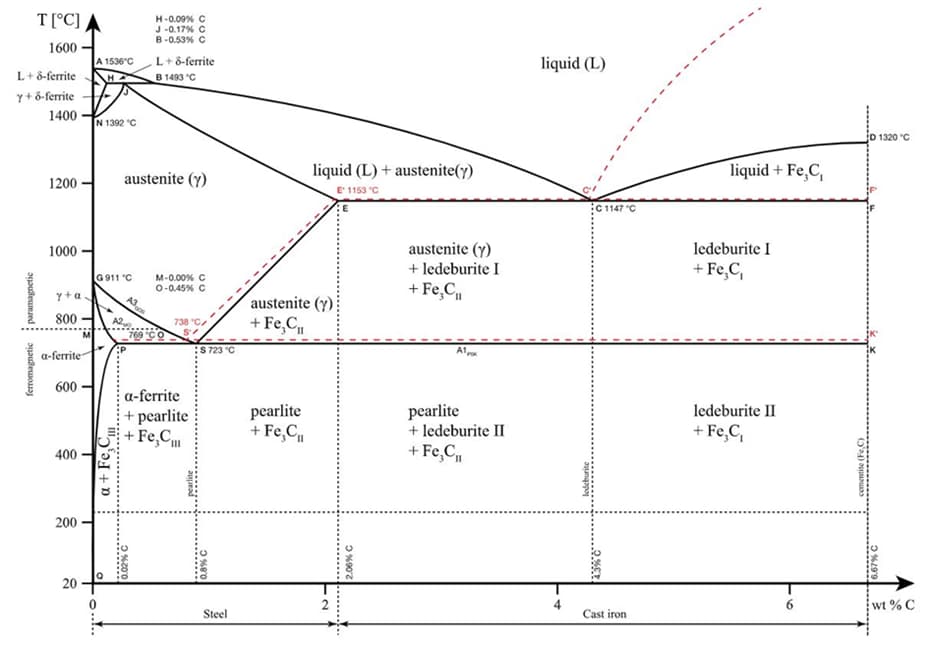Steel, a fundamental material in modern industrial applications, owes its versatility and performance to the careful inclusion of various alloying elements. Alloying elements are introduced to steel to alter its properties, enhancing its strength, durability, corrosion resistance, and other crucial characteristics.
Steels are manufactured by combining iron with carbon, a process integral to steelmaking. The sourcing of materials for steel production can come from either iron ore or scrap metal, which undergo refining and processing. The resultant liquid steel is then shaped into ingots through casting or formed into billets or blooms using continuous casting methods. However, the properties of steel heavily depend on the incorporation of alloying elements.
Throughout the last two centuries, humanity has greatly benefitted from the utilization of steel and alloying elements. A comprehensive understanding of the alloying process can be gleaned from the iron-carbon equilibrium diagram. Alloys derived from iron and carbon fall into two categories: steel and cast iron. Alloys containing up to 2.14% carbon content in iron are categorized as steel, while those ranging from this composition to 6.7% carbon content by weight are classified as cast iron.

A crucial phase transformation, known as the eutectic transformation, occurs at 727°C, which involves a composition of 0.76% carbon by weight. This phase transformation marks a significant point in the alloy’s behavior, influencing its properties and characteristics.
The addition of various alloying elements introduces distinctive attributes to the steel. For instance, manganese aids in deoxidation and enhances strength, while nickel contributes to improved toughness and corrosion resistance. Chromium’s inclusion forms a protective oxide layer, fortifying the steel against corrosion and elevating its strength.
Moreover, alloying elements such as molybdenum, vanadium, and silicon play specific roles in augmenting steel properties. Molybdenum enhances high-temperature strength and hardenability, vanadium boosts toughness and wear resistance, and silicon improves elasticity and oxidation resistance.
Understanding the impact of alloying elements within the iron-carbon system is vital for tailoring steel properties to meet diverse industrial requirements. Engineers and metallurgists carefully select and balance these elements to achieve desired characteristics such as strength, hardness, ductility, and corrosion resistance in the final steel product.
In essence, the synergy between iron, carbon, and alloying elements is fundamental to the versatility and utility of steel in various sectors, facilitating innovation and technological advancements over centuries.
Carbon is the main alloying element of steel. Some impurities may be formed during alloying and it may contain small amounts of other elements as a result of external factors. We can classify steels in 3 different ways according to their composition:
Carbon steels;
- Low carbon steels (C <0.25%)
- Medium carbon steels (0.25% <C <0.55%)
- High carbon steels (0.55% <C)
Alloy steels;
- Low alloy steels : Low alloy steels contain less than 5% alloying elements in their composition.
- High alloyed steels :High alloy steels contain more than 5% alloying elements in their composition.
Steels according to the alloying element in their composition;
- Stainless steels
- Manganese steels
- Chrome-nickel steels
Alloying Elements and How They Effect the Steel
Carbon,
Carbon, serving as the primary alloying element in steel, notably enhances mechanical properties such as strength, hardness, and overall mechanical resilience. However, this enhancement comes with trade-offs, as it inversely impacts malleability, ductility, and toughness. As the carbon content in steel composition increases, there’s a noticeable decrease in its malleability, ductility, and toughness, leading to a gradual shift towards more brittle characteristics.
While an increase in carbon content can initially bolster the steel’s tensile strength, this effect reaches a threshold point. Beyond this threshold, heightened carbon content diminishes the material’s ductility, resulting in a tendency towards brittle behavior. High carbon steels, particularly susceptible to this effect, may experience a risk of cracking due to the presence of residual austenite post heat treatment, posing challenges in forging and impacting weldability negatively.
Chromium
Chromium stands out as one of the frequently employed alloying elements in steel. Its pivotal contribution lies in imparting stainless properties to steel by forming a protective and lustrous oxide layer on the steel surface. Stainless steel compositions typically contain around 12% chromium. Additionally, chromium enhances hardness by fostering the formation of carbides within the steel matrix. Similar to carbon, it elevates tensile strength and bolsters heat resistance; however, this enhancement comes at the cost of reduced ductility.
Nickel
Steel compositions may include nickel in amounts of up to 5% by weight. Nickel serves to enhance the material’s hardness and strength without compromising its ductility and toughness, a distinctive advantage compared to chromium and carbon. Due to this unique attribute, nickel finds extensive use in the production of stainless steel.
Manganese
Manganese serves to enhance the mechanical properties of steels by augmenting their strength while diminishing ductility. Additionally, it enhances malleability by engaging with sulfur present in the composition. From a thermal perspective, manganese extends the depth of quenching. Its capacity to bolster hardness and strength relies on the carbon content within the material. Moreover, manganese can potentially improve the weldability of the material.
Sulfur
Sulfur is generally considered an unwanted alloying element except in the case of free-cutting steel due to its tendency to induce brittleness in steel. To mitigate this effect, measures are taken to minimize its impact by engaging with manganese. In free-cutting steels, however, sulfur is intentionally included in the composition to aid in machining processes.
Silicon
Silicon is used as an oxygen and degassing agent during production. It also provides fluidity in casting. It improves the magnetic properties of steel and increases its heat resistance. While it increases the hardenability and wears resistance of the material, it adversely affects the surface quality.
Molybdenum:
Its application is to avert temper brittleness in steels featuring molybdenum, low chromium, and nickel content. Molybdenum significantly enhances steel’s heat resistance and amplifies the effects of other alloying elements. Consequently, it is frequently employed not in isolation but in conjunction with other alloying elements. Molybdenum interacts with carbon to create carbides, contributing to heightened hardness, making it a prevalent choice in the production of tool steels.
Vanadium
Vanadium serves to elevate the strength, hardness, and wear resistance of steels. Even small additions of vanadium can effectively impede grain coarsening. Furthermore, conventional tempering and softening procedures following heat treatment do not significantly affect vanadium-influenced steel, hence its prevalent application in tool steels.
Tungsten
Tungsten serves to enhance the wear resistance, hardness, and toughness of steels, offering improved performance in high-temperature conditions during hot working and cutting operations. Due to these properties, tungsten is widely favored in tool steels, high-speed steels, and the construction of heat-resistant steel structures.
Cobalt
Cobalt retards grain coarsening when exposed to high temperatures, consequently augmenting the material’s heat resistance and strength under elevated temperature conditions. This attribute makes cobalt a favored choice in the production of tool steels.
Aluminum
Aluminum serves as a deoxidizing agent and contributes to grain refinement, effectively impeding the enlargement of austenite grains. Its presence enhances aging resistance, which is why aluminum is incorporated into the structure of deep-drawn sheets.
Phosphorus
Similar to sulfur, phosphorus renders steel brittle, making it an undesirable element in steel composition. While phosphorus contributes to increased hardenability, it significantly compromises ductility, particularly noticeable in high carbon steels.
Copper
Copper contributes to enhancing corrosion resistance and hardness in steel. However, its inclusion substantially diminishes ductility. Therefore, it is typically limited to a maximum of 0.5% in steel compositions\
Nitrogen
Nitrogen enhances the strength and hardness characteristics of steel by forming nitrides within its structure. This element aids in the machining process but concurrently elevates the material’s fragility.
